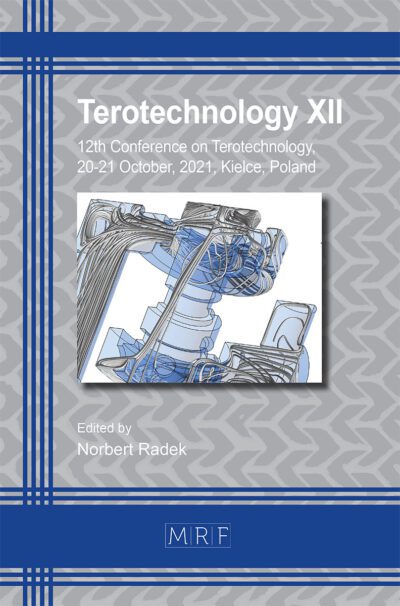Simulation of hollow embossing rolling for full-scale bipolar plates
Franz Reuther, Sven Winter, Verena Psyk, Verena Kräusel
Abstract. Hollow embossing rolling is a high-potential technology for the continuous production of metallic bipolar half plates (BPHP) for fuel cells and other plates for media distribution, enabling high-speed manufacturing. While finite element (FE) models for smaller BPHP samples have demonstrated significant accuracy and efficiency in predicting key process parameters, their application to full-scale BPHPs remains underexplored. This study focuses on extending a previously validated FE modeling approach to simulate the hollow embossing rolling of a full-scale BPHP using LS-DYNA R12.1. The investigation evaluates critical aspects of process behavior, including process parameters, wrinkling tendencies, thinning behavior, and the achievable cross sectional channel shapes. Additional simulations are performed to evaluate springback and resulting flatness deviations under clamped conditions. The results confirm that the modeling strategy effectively predicts the behavior of full-scale BPHPs during hollow embossing rolling. The process is feasible without cracking; however, geometry-induced wrinkling and flatness deviations remain a challenge, indicating the need for further optimization.
Keywords
Sheet Metal Forming, Simulation, Bipolar Plates, Hollow Embossing Rolling
Published online 5/7/2025, 10 pages
Copyright © 2025 by the author(s)
Published under license by Materials Research Forum LLC., Millersville PA, USA
Citation: Franz Reuther, Sven Winter, Verena Psyk, Verena Kräusel, Simulation of hollow embossing rolling for full-scale bipolar plates, Materials Research Proceedings, Vol. 54, pp 1972-1981, 2025
DOI: https://doi.org/10.21741/9781644903599-212
The article was published as article 212 of the book Material Forming
![]() Content from this work may be used under the terms of the Creative Commons Attribution 3.0 license. Any further distribution of this work must maintain attribution to the author(s) and the title of the work, journal citation and DOI.
Content from this work may be used under the terms of the Creative Commons Attribution 3.0 license. Any further distribution of this work must maintain attribution to the author(s) and the title of the work, journal citation and DOI.
References
[1] N. Konno, S. Mizuno, H. Nakaji et al., Development of Compact and High-Performance Fuel Cell Stack, SAE Int. J. Alt. Power., 1, 4 (2015), 123–29, https://doi.org/10.4271/2015-01-1175
[2] Riemer, M.; Zheng, L.; Eckstein, J. et al., Future hydrogen demand: A cross-sectoral, global meta-analysis, HYPAT Working Paper 04/2022 (2022), https://www.isi.fraunhofer.de/content/dam/isi/dokumente/cce/2022/HYPAT_Working_Paper_04_2022_Future_hydrogen_demand.pdf
[3] S. Porstmann, T. Wannemacher, W.-G. Drossel, A comprehensive comparison of state-of-the-art manufacturing methods for fuel cell bipolar plates including anticipated future industry trends, J. Manuf. Process., 60 (2020), 366–83, https://doi.org/10.1016/j.jmapro.2020.10.041
[4] S. Porstmann, S. Polster, F. Reuther et al., Objectives and fields of tension in the comparison of manufacturing processes for metallic bipolar plates, Fuel Cell Conference FC³, Chemnitz, 2021
[5] B. Abeyrathna, P. Zhang, M. P. Pereira et al., Micro-roll forming of stainless steel bipolar plates for fuel cells, Int. J. Hydrogen Energy, 7, 44 (2019), 3861–75, https://doi.org/10.1016/j.ijhydene.2018.12.013
[6] A. Bauer, Experimentelle und numerische Untersuchungen zur Analyse der umformtechnischen Herstellung metallischer Bipolarplatten, Dissertation, Technische Universität Chemnitz, 2020
[7] F. Reuther, V. Psyk, V. Kräusel et al., Simulation of Hollow Embossing Rolling for Bipolar Plate Forming using LS-DYNA©, 14th European LS-DYNA Conference, Baden-Baden, 2023
[8] F. Reuther, M. Dix, V. Kräusel et al., Model validation of hollow embossing rolling for bipolar plate forming, Int J Mater Form, 2, 17 (2024), https://doi.org/10.1007/s12289-023-01804-w
[9] M. Wagner, M. Alaluss, R. Kurth et al., Characterization of the Machine Behavior During Hollow Embossing Rolling of Metallic Bipolar Half Plates, Journal of Machine Engineering (2023), https://doi.org/10.36897/jme/167525
[10] M. Fiedler, K. Kittner, B. Awiszus, Production of Metallic Bipolar Plates Made of Stainless Steel by Incremental Hollow Embossing Using Rollers, in: Dix, M., Kräusel, V. (Eds.), The 28th Saxon Conference on Forming Technology SFU and the 7th International Conference on Accuracy in Forming Technology ICAFT, MDPI-Verlag, Basel, 2022
[11] M. Weiss, P. Zhang, M. P. Pereira et al., Understanding Size Effects and Forming Limits in the Micro-Stamping of Industrial Stainless Steel Foils, Metals, 1, 11 (2021), 38, https://doi.org/10.3390/met11010038
[12] D. Liu, L. Peng, X. Lai, Effect of dimensional error of metallic bipolar plate on the GDL pressure distribution in the PEM fuel cell, Int. J. Hydrogen Energy, 2, 34 (2009), 990–97, https://doi.org/10.1016/j.ijhydene.2008.10.081
[13] P. Woizeschke, F. Vollertsen, Laser keyhole micro welding of aluminum foils to lap joints even with large gap sizes, CIRP Annals, 1, 69 (2020), 237–40, https://doi.org/10.1016/j.cirp.2020.04.063
[14] D. Qiu, P. Yi, L. Peng et al., Study on shape error effect of metallic bipolar plate on the GDL contact pressure distribution in proton exchange membrane fuel cell, Int. J. Hydrogen Energy, 16, 38 (2013), 6762–72, https://doi.org/10.1016/j.ijhydene.2013.03.105














